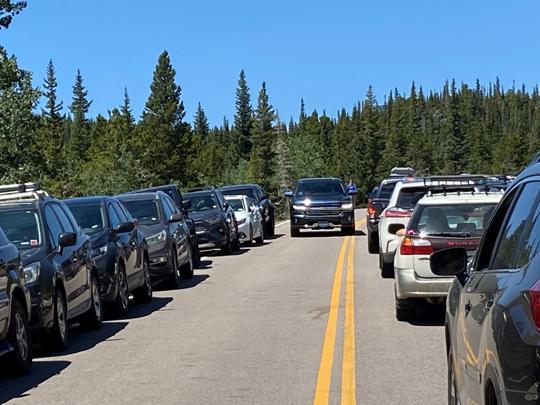
This story is from January in the Colorado Springs Gazette, a Seth Boster piece on the impacts of Covid recreation. It features an interview with Scott Fitzwilliams, Forest Supervisor of the White River National Forest. If you have a similar story in your local media, please share the link in the comments. There’s also some good photos. Apparently there has also been an increase in people moving to Colorado due to Covid, which adds another crowding factor. What I like about this issue is that there are no “bad groups” to stereotype and moralize about, and there’s no partisan angle. The only bad folks are individual recreationists who.. behave badly.
It’s well worth reading in its entirety, and quotes a number of people, but I just excerpted the part on “management scenarios.”
Which begs the question: Could crowd control strategies tried in the summer of COVID-19 be here to stay?
At the Hessie trailhead, for example, the ranger district partnered with sheriff’s deputies. “They were turning people around by the hundreds on busy weekends after parking was full,” Armstrong says.
North of there, at Brainard Lake, a timed entry system was tried. Arapaho National Forest’s most famous destination, Mount Evans Scenic Byway, remained closed, as public health guidelines made opening tricky, Armstrong says. “We’re beginning to have conversations on what to do next year.”
Such conversations are ongoing well beyond that summit.
Reservations continue to be enforced at the Manitou Incline, the iconic trail in Manitou Springs that local leaders closed in March under an emergency order. Similarly, in an announced effort to prevent the coronavirus spread, Rocky Mountain National Park enacted a booking system over the summer that some onlookers see as the future for other overrun national parks in the West.
Another reservation system was born this summer at another Colorado natural treasure: the Maroon Bells. Beyond that scenic area, in the Maroon-Snowmass Wilderness, reservations and permits could soon be required, says Fitzwilliams, who oversaw reservations rolled out in 2019 for Hanging Lake near Glenwood Springs.
And he expects more talks regarding more “management scenarios” at other sites under siege, mentioning spots near Vail and Summit County in particular. Above Breckenridge, at the base of Quandary Peak, 14,000-foot summit fever once again led to overflow on the adjacent highway, the lines of cars on either side of the road and jammed parking lot causing hazards for emergency vehicles.
“If things keep growing the way they are, it’s inevitable that some of these areas are going to have to have some management scenarios, either permits or reservations or some sort of those types of tools,” Fitzwilliams says.
“It’s just the way it is. The old days aren’t here anymore.”
In the old days, there were more staff and resources, Fitzwilliams says. Since he started at White River National Forest 11 years ago, the budget he oversees has plunged 45%, he says. The busiest national forest serves as a microcosm for broader cuts to the U.S. Forest Service over recent years.
“We’re hitting a point where we can’t keep going down while the use (of lands) and output keeps going up,” Fitzwilliams says.
Similar scenario in SW CO:
https://durangoherald.com/articles/355895
Thanks, Dana!